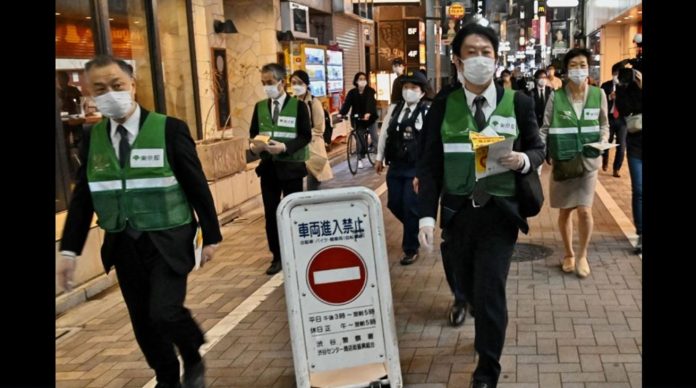
Aug. 30 (UPI) — Abusive infant head trauma in France and domestic violence in Japan increased during the pandemic, showing the unintended consequences of trying to contain the spread of COVID-19 on the most vulnerable members of society.
That’s according to two studies published Tuesday in JAMA Network Open.
In the first study, researchers found a marked increase in the incidence and severity of abusive head trauma in infants from 2020 to 2021, during the pandemic’s first two years, in the Paris metropolitan area compared with the pre-pandemic period from 2017 to 2019.
The incidence of abusive head trauma in babies under a year old — the most severe form of child abuse and neglect — increased 2.5 times from July to December 2021 alone, compared with the pre-pandemic period.
Separately, a second study found the rates of consultations for people seeking help from domestic violence increased during the COVID-19 pandemic in Japan.
The researcher said the increase may have been due to an array of factors, “including economic instability, increased exposure to exploitative relationships and reduced support options.”
Such findings should prompt awareness among healthcare professionals and lead to new prevention strategies, researchers said.
The French study included cases of abusive head trauma in infants up to 12 months old, referred between January 2017 and December 2021 to Necker Hospital for Sick Children, the single regional pediatric neurosurgery center for the Paris metro area.
Dr. Alina-Marilena Lãzãrescu, a pediatrician in the hospital’s Department of Pediatric Anesthesia and Intensive Care, led the study.
Babies in the study had faced one or more subdural hemorrhages — bleeding between the brain and skull from severe head injury. Abusive head trauma was assessed by a multidisciplinary evaluation after a social, clinical, biological, and radiological workup.
Thirteen of the 99 infants with abusive head trauma died. Among the babies, with a median age of 4 months, 86 had bridging vein thrombosis; 74 had retinal hemorrhages; 23 had fractures; and 26 had status epilepticus, defined as a seizure lasting longer than 5 minutes, or having more than 1 seizure within a 5-minute period without returning to a normal level of consciousness between episodes.
Twenty infants had skin injuries, and 53 had to undergo neurosurgery, according to the research paper.
Compared with the pre-pandemic period from 2017 to 2019, the incidence of abusive head trauma in babies under 12 months old was stable in 2020, and then significantly increased in 2021.
The researchers said in their paper that measures taken to contain the pandemic “deteriorated the psychosocial situation of adults, increased the periods where parents or guardians were at home for a prolonged time with their children, and reduced the intensity of prevention and early detection programs” for child abuse and neglect.
According to the researchers, abusive head trauma is the most frequent cause of traumatic death in infants in high-income countries. If babies survive, they may face “microcephaly, epilepsy, motor and visual deficiencies, language disorders, intellectual disability and behavioral abnormalities,” leading to severe lifelong disabilities.
They said efforts taken to reduce the spread of the coronavirus may have added to the risk of infant abuse because of “psychosocial distress,” including “economic loss and unemployment, frustration intolerance, adult psychiatric disorders, and intimate partner violence.”
Also cited were lifestyle changes during the pandemic’s first two years, including remote work from home, school and childcare facility closures, complete national lockdowns and curfews, as well as disorganized social services.
The investigators noted the Paris metro area is densely populated with two-thirds of its population living in small collective housing; and strong COVID-19 outbreaks led to prolonged lockdowns and curfews, remote work obligations and daycare center shutdowns.
According to second study, the rates of people seeking professional help for domestic violence have increased steadily in Japan since 2011. But there was “a considerable upward trend” during the COVID-19 pandemic.
Again, the investigator cited pandemic restrictions that “increased time spent in domestic settings and contributed to income instability for both perpetrators and survivors” of domestic violence.
The study’s author was Xerxes T. Seposo, associate professor in the Department of Hygiene at the Graduate School of Medicine at Hokkaido University in Sapporo.
From 2011 to 2020, just over 1 million inquiries related to domestic violence were made in Japan, the research paper said. Of these, 98.1% were from females. Two-thirds of inquiries were made via call centers, while most of the rest were made during visits to facilities.
Annual inquiry rates for domestic violence rose to 38 per 1,000 population per reporting facility during the pandemic versus 32 per 1,000 before the pandemic, the investigator said.
And call center-based inquiries increased significantly during the pandemic: to 86,168 such calls in 2020, up from 68, 279 such calls annually from 2011 to 2019.
In his research paper, Seposo urged caution in trying to generalize Japan’s results to other countries.





